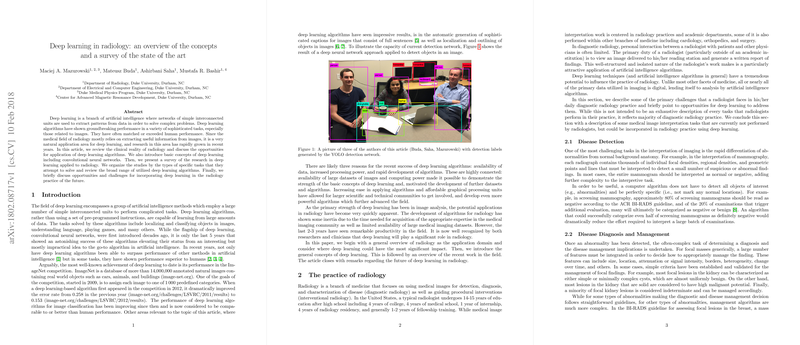Deep Learning Applications in Radiology: A Survey
Deep learning, a key domain within artificial intelligence, leverages networks composed of interconnected units to identify patterns in data, enabling the resolution of complex problems. Among its various successful applications, deep learning has demonstrated exceptional performance in tasks involving image analysis, achieving levels that occasionally rival or exceed human capabilities. Given that radiology predominantly revolves around deriving information from images, the intersection of these two fields is a natural avenue for exploration.
The paper in question provides a comprehensive review of the current landscape and potential applications of deep learning within radiology. It meticulously details the clinical environment of radiology, highlighting specific opportunities where deep learning could be most beneficial. The introduction of deep learning is framed by a discussion of its foundational components, particularly convolutional neural networks (CNNs), which are pivotal in the processing and analysis of visual data.
In a structured survey of existing research, the paper categorizes studies based on the distinct radiological tasks being addressed. This taxonomy aids in understanding the diversity and specificity of deep learning applications across different radiological functions. Moreover, the survey encompasses a wide array of algorithms employed in these studies, demonstrating the versatility and adaptability of deep learning techniques to various radiological needs.
Significantly, the paper underscores both the opportunities and the challenges associated with integrating deep learning into clinical radiology practice. The potential for improved accuracy in diagnostics, enhanced workflow efficiency, and reduced human error presents compelling advantages. However, challenges remain, including issues related to data privacy, the necessity for large annotated datasets, and the integration of AI tools within existing medical infrastructure.
This work invites further exploration and development in the deployment of deep learning in radiology. Practically, advancements could lead to profound changes in diagnostic processes, potentially reducing costs and increasing accessibility to high-quality medical care. Theoretically, this intersection poses questions about how best to harmonize AI-driven diagnostics with current medical practices to ensure trust and reliability.
In conclusion, the paper provides a critical analysis of the burgeoning relationship between deep learning and radiology. Its insights not only reflect on the current state of research but also anticipate how future developments in AI could transform radiological practices, underscoring the importance of continued investigation in this promising area.
